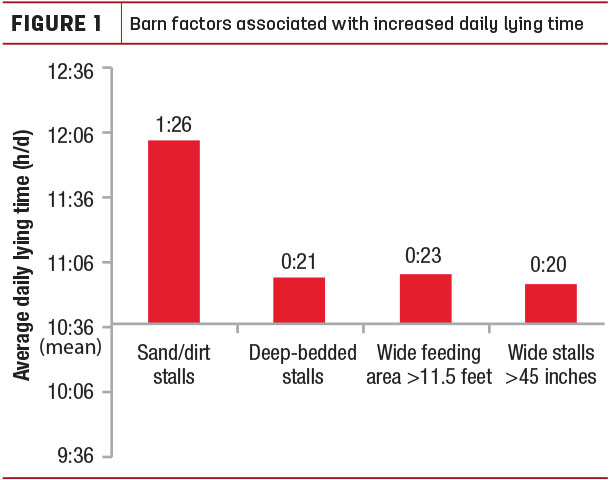The following summary is part of a Dairy Farmers of Canada-funded Dairy Research Cluster study examining dairy cow comfort, lameness and longevity. The study included data from 141 freestall farms in Quebec, Ontario and Alberta. Lying behavior was automatically recorded on 5,135 cows using accelerometers over four days.
Information on factors that may influence lying behavior was collected, including data on lameness, days in milk, lactation number, milk production, management practices and barn design. Here is a snapshot of those findings.
Is longer lying time always a sign of greater comfort?
Over the past decade, we have seen increasing research on automated measures of cow behavior, including the use of lying time as an indicator of disease and cow comfort. Creating a comfortable environment for dairy cows results in better productivity, health and welfare, and the portion of time throughout a day that a cow spends lying or resting is an important measure of comfort.
Therefore, when assessing cow comfort, a lot of attention is given to daily lying time, and a target of 12 hours per day of lying time has been recommended by many researchers and the Canadian Dairy Code of Practice. However, lying is a complex behavior affected by many factors, and an average number for a herd doesn’t tell the whole story.
In our study, on most farms (92 percent), cows did not reach the recommended target of 12 hours per day of rest. On average, cows were lying down for 10:36 hours per day. As expected, lying behavior was different between lame and non-lame cows, lame cows being the ones lying down longer. (Lame cows lay 11:06 hours per day; non-lame cows lay 10:30 hours per day.)
Overall, lame cows exhibited both extremely long and extremely short lying times (less than or equal to six or greater than or equal to 15 hours per day). They may lie down longer because rising is challenging (not necessarily because they are more comfortable), or they may reduce resting time because lying down is challenging.
So if we only assess an average lying time without information on other factors, such as lameness status or stall comfort, we might conclude longer lying times indicate more comfortable cows when they may, in fact, indicate more lame cows.
Can lying behavior detect lameness?
Cows are more likely to be lame if their lying time is much lower or higher than average, suggesting that lying behavior can be used for early lameness detection. However, changes in lying time can be both the cause and the consequence of lameness, making the link between lying behavior and lameness more complicated.
In our study, lying behavior did not accurately detect lameness, mostly because there are many other factors happening in and around the cow that influence lying behavior. Lying time among individual cows in a single herd varied more (from one to 22 hours per day) than the average lying time across all 141 herds (eight to 13 hours per day).
A lot of this wide variation in lying behavior was due to individual factors like days in milk and lactation number, and this in turn was affected by the comfort of the lying surface. First-lactation cows behaved differently than older cows, and fresh cows behaved differently than cows in late lactation.
Let’s face it: Locomotion scoring is a time-consuming and tedious process. It would be ideal if lameness data were collected automatically and provided to farmers in real time, facilitating early detection and treatment. But until now, such systems have not been adopted on a commercial scale, mostly because they have not proven to be highly accurate and the market may not be big enough.
Perhaps combining several measures of behavior and sensor technologies to detect cows’ deviation from normal behavior on a day-to-day basis could increase the accuracy of lameness detection, but that is yet to come.
What factors in the barn influence lying time?
We looked at dozens of factors in the barn and management that could influence lying behavior. However, lying time was only affected by the type and depth of bedding and the width of the stalls and feed alley (on cow side). See Figure 1.

On average, cows were lying down for 10:36 hours per day. But cows housed in barns with sand or dirt bedding lay down 1:36 hours longer than the average. Cows housed in barns with either deep-bedded stalls (greater than 2 centimeters of bedding), feeding alleys 11.5 feet wide or wider, or stalls 45 inches wide or wider, had approximately 20 more minutes of lying time than the average.
These findings reinforce the idea that adopting management practices intended to improve cow comfort, specifically the comfort of lying and standing surfaces, will have an impact on lying behavior.
In summary, given that cows change their lying behavior depending on days in milk, lactation number, health status and other demands on their time budgets, we need to be cautioned when evaluating farms or cows based on average daily lying times.
We know that rest should be prioritized and encouraged by maintaining a comfortable lying surface, and we should aim for long lying times. However, recommendations about optimum lying times must take into account several factors specific to the cow instead of focusing on an average number for the herd at any point in time. ![]()
This is a report from the Calgary Lameness Research Team, which includes Casey Jacobs, Emily Morabito, Karin Orsel, Herman Barkema, Steve Mason, Ed Pajor and Gordon Atkins.

-
Laura Solano
- Farm Animal Care Associates
- Email Laura Solano






